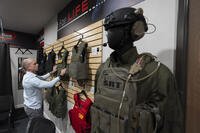 Common sense tells you that wearing your helmet and body armor in combat will increase your odds of survival, but British Army researchers said evidence to objectively demonstrate the advantage of body armor is scarce.
Common sense tells you that wearing your helmet and body armor in combat will increase your odds of survival, but British Army researchers said evidence to objectively demonstrate the advantage of body armor is scarce.
A British medical unit mapped the surface wounds of all NATO and Afghan troops treated at the field hospital at Camp Bastion, Afghanistan, from July 8 to October 12, 2012. The doctors and nurses compared the wounds with the body armor the soldiers wore. They also mapped the wounds of those who did not have the protective helmet or armor on at the time they were hit.
And what they found was that troops wearing a helmet were 2.7 times less likely to sustain a fragmentation wound to the head than those that were unprotected. Body armor made it 4.1 times less likely that the soldier would suffer a fragmentation wound to the chest or abdomen, while a pelvis protector improved the wearer’s odds against a wound to the pelvic area by 10 times.
Wounds are logged in a Joint Theatre Trauma Registry, which was established by the U.S. military in 2005. But the registry does not relate a particular wound or injury to body armor coverage, according to an article on the study in the March issue of The Journal of the Royal Army Medical Corps.
So the British team at Camp Bastion created a computerized surface wound mapping program that related the two things. They also scored the wounds in accordance with an international system for classifying injuries or wounds, their location and severity.
“Computerized [surface wound mapping] has objectively demonstrated the ability of body armour worn on current operations in Afghanistan to reduce wound incidence and severity,” the researchers said.
The authors concede that the study and its results are specific to the war in Afghanistan, and that a different conflict could see a difference in the kinds and severity of wounds among troops donning body armor.
“However, gathering electronic SWM at the same time as recording injuries for the [Joint Theatre Trauma Registry] was simple, required little extra time and therefore we would recommend its collection during future conflicts,” the British doctors said.








